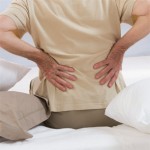Certain populations of patients with rheumatic disease also are more prone to back pain. For example, spondyloarthritis is specifically associated with inflammatory back pain.5 In postmenopausal women, back pain is significantly associated with RA, and it can be predictive of vertebral fractures.6
In patients with RA, the use of ambulatory devices—walkers, crutches, and wheelchairs—can cause back pain because the devices change the patient’s body mechanics and posture, Dr. Richardson says. Fibromyalgia and AS are also likely to cause back pain, she adds.
Prevention
The increasingly sedentary nature of the U.S. workplace today is causing back pain. Sitting for long periods of time—such as for eight hours a day at a computer—puts a lot of pressure on the spine. The same is true of manual labor or any job that requires frequent bending. Effective ways to prevent back pain and maintain a healthy spine include focusing on posture, making time to change positions throughout the day, staying physically active, and maintaining a healthy weight.
“Keeping in tune with good posture and trying to maintain that posture as long as you can throughout the day” is good for general spine health and preventing pain, according to Sarah Schoenhals, DPT, PT, inpatient rehabilitation physical therapist at Carondelet St. Joseph’s Hospital in Tucson, Ariz. This means maintaining the three natural curves of the spine during everyday activities, such as picking something up from the floor or sitting at a desk. “This can be achieved through strengthening specific muscles and sometimes stretching other muscles,” she says. “When you’re sitting at your desk and you get in that ‘lazy’ position—rounded shoulders and slumped forward—you lose all those natural curves.”
In addition to maintaining good posture, another general rule is to avoid staying in one position for long periods of time, Dr. Schoenhals says. “If someone sits for eight hours, suggest they get up and walk around or go somewhere they can lie down to relieve the pressure from their low back sporadically throughout the day,” she added.
Being physically active and keeping weight down is another key to preventing back pain. “In general, folks who maintain a healthy lifestyle as far as physical activity tend to have better outcomes and are less likely to report low back pain,” says Adam Goode, PT, DPT, PhD, assistant professor of community and family medicine at Duke University in Durham, N.C. For his patients, Dr. Goode recommends regularly participating in an activity they enjoy, as opposed to making specific suggestions, because if the patient picks something they like doing, it helps ensure that they’ll do it.


